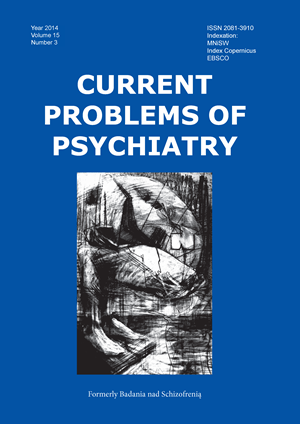Understanding humour as a dimension of affective and cognitive competencein patients diagnosed with paranoid schizophrenia
Keywords:
paranoid schizophrenia, sense of humor, competence affective, cognitive functionsAbstract
The aim of our study was to analyze the ways of thinking of patients diagnosed with paranoid schizophrenia, and compare this with that of healthy individuals. This was done by ascertaining their reception and interpretation of the positive affective impulses induced by way of the core dimensions of humour: comicality and level of understanding of jokes. The study involved a group of 22 persons, including 11 patients diagnosed as having paranoid schizophrenia, and who are being treated in The Second Psychiatry and Psychiatric Rehabilitation Department in Lublin. The other 11 persons, without any clinical diagnosis (never treated by psychiatrists), serve as a control group.
The research material was gathered based on standard methods of neuropsychological assessment: sub-tests of the WAIS-R (PL) battery, including “span forward”,” span backward”, “vocabulary” and “understanding”. This method of testing was chosen because the multidimensional construct of the sense of humour requires great intellectual capacity, suitable cognitive function and adequate affective competences. The analysis was complemented by data gathered from a study questionnaire designed for assessing the level of understanding of chosen emotional contents presented in the form of jokes. Jokes were chosen as the means of measurement, because we felt that the reaction to these to be the simplest way of comparing the exhibition of a sense of humour. The results clearly indicate that persons afflicted with paranoid schizophrenia assessed the comicality of the presented jokes at a significantly lower level. Moreover, they demonstrated a lower level of adequacy of their understanding. These recognized deficits may imply a correlation between lowered level of perception and interpretation of comical affective contents, and the core cognitive restrictions and negative emotional symptoms observed more often in persons with paranoid schizophrenia.
References
1. Falkenberg I., Klügel K. ,Bartels M., Wild B. (2007). Sense of humor in patients with schizophrenia. Schizophrenia Research. 95; 259–261.
2. Ravlings D. (2008). Relating humor preference to schizotypy and autism scores in a student sample. Humor: International Journal of Humor Research. 21; (2), 197-219.
3. Polimeni J., Campbell D. W., Gill D., Sawatzky B.L., Reiss J.P. (2010). Diminished humour perception in schizophrenia: Relationship to social and cognitive functioning. Journal of Psychiatric Research 44; 434–440.
4. Yip J. A., Martin R. A. (2006). Sense of humor, emotional intelligence, and social competence. Journal of Research in Personality 40;1202–1208.
5. Marjoram D., Tansley H., Miller P., MacIntyre D., Cunningham Owens D. G., Johnstone E. C., Lawrie S. (2005). A Theory of Mind investigation into the appreciation of visual jokes in schizophrenia. BioMedicalCentral Psychiatry 2005, 5-12.
6. Weisfeld G. E. (1993). The adaptive value of humor and laughter. Ethology and Sociobiology Volume 14, Issue 2, March 1993, Pages 141–169.
7. Willibald R. (1998) Foreword and overview, Sense of humor: A new look at an old concept. [w:] R. Willibald (red.) The sense of humor. Mouton de Gruyter, Berlin.
8. Plessner H. (2004). Śmiech i płacz. Badania nad granicami ludzkiego zachowania. Kęty: Wydawnictwo ANTYK.
9. Tomczuk-Wasilewska J. (2009). Psychologia humoru. Lublin: Wydawnictwo KUL
10. Szymczak M. (1998a) (red.) Słownik języka polskiego. Warszawa: Wydawnictwo PWN, I tom.
11. Szymczak M. (1998b) (red.) Słownik języka polskiego. Warszawa: Wydawnictwo PWN, II tom.
12. Martin, R.A., Dobbin J.P. (1988). A Sense of Humor, Hassles, and Immunoglobulin A: Evidence for a Stress-Moderating Effect of Humor. The International Journal of Psychiatry in Medicine, 18(2), 93-105.
13. Patrzała A. (2010). Rozprawa doktorska Amelii Patrzały, zatytułowanej „Badania cech kreatywności u chorych na schizofrenię”. Poznań: Uniwersytet Medyczny im. Karola Marcinkowskiego.
14. Bartolo A, Benuzzi F, Nocetti L, et al. (2006). Humor comprehension and appreciation: an fMRI study. Journal of Cognitive Neuroscience;18:1789–98.
15. Samson AC, Zysset S, Huber O. (2008). Cognitive humor processing: different logical mechanisms in nonverbal cartoons - an fMRI study. Social Neuroscience;3:125–40.
16. Goel V, Dolan RJ. (2007). Social regulation of affective experience of humor. Journal of Cognitive Neuroscience;19:1574–80.
17. Parnowska D., Braniecka A., Radomska A. (2013). Poczucie humoru w schizofrenii – zdolność do odbioru komizmu i możliwość jego wykorzystania w oddziaływaniach terapeutycznych. Psychiatria Polska, 5, 945 – 956.
18. Braniecka A., Parnowska D., Radomska A. (2012). Poczucie humoru u pacjentów z depresją – przegląd badań. Psychiatria Polska, 6, 1007-1018. 9.
19. Jędrasik-Styła M, i wsp. (2012). Bateria testów MATRICS-standard oceny funkcji poznawczych w badaniach klinicznych schizofrenii. Psychiatria Polska, 2, 261-271.
20. Martin RA. (2003). Sense of humor. W: Lopez SJ, Snyder CR. red. Positive psychological assessment. A handbook of models and measures. Washington, DC: American Psychological Association. s. 313–326.
21. Polimeni JO, Reiss JP. (2006a). Humor perception deficits in schizophrenia. Psychiatry Research, 141, 229-32.


